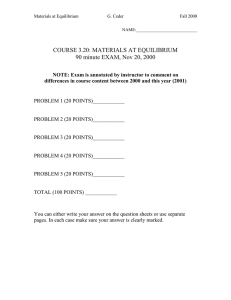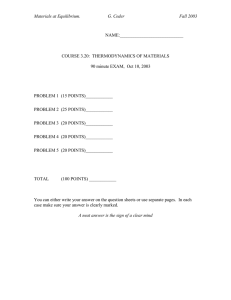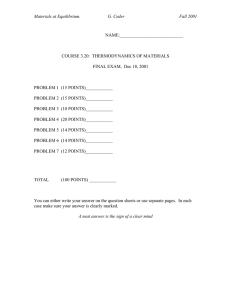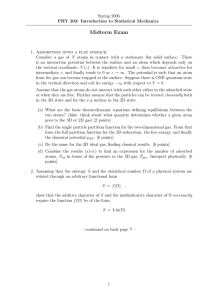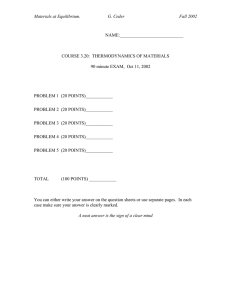Materials at Equilibrium. G. Ceder Fall 2001 NAME:____________________________
advertisement
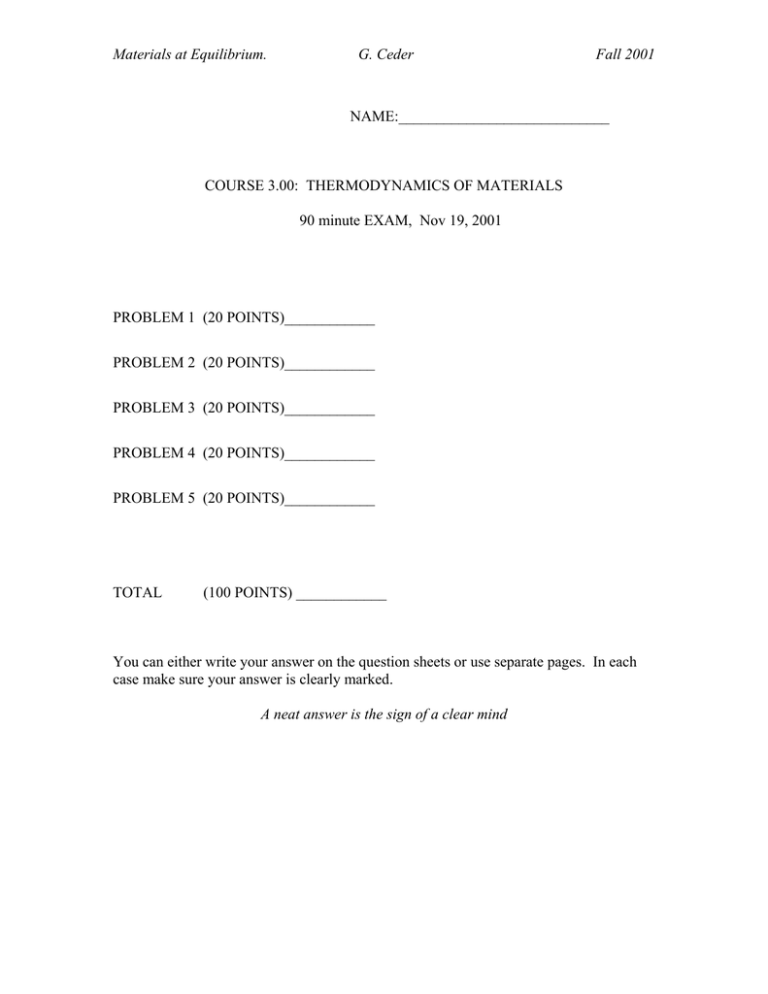
Materials at Equilibrium. G. Ceder Fall 2001 NAME:____________________________ COURSE 3.00: THERMODYNAMICS OF MATERIALS 90 minute EXAM, Nov 19, 2001 PROBLEM 1 (20 POINTS)____________ PROBLEM 2 (20 POINTS)____________ PROBLEM 3 (20 POINTS)____________ PROBLEM 4 (20 POINTS)____________ PROBLEM 5 (20 POINTS)____________ TOTAL (100 POINTS) ____________ You can either write your answer on the question sheets or use separate pages. In each case make sure your answer is clearly marked. A neat answer is the sign of a clear mind Materials at Equilibrium. G. Ceder Fall 2001 Question 1 An iron rod of length l and made up of N iron atoms is held in vacuum (P=0) under uniaxial tension with a constant force F, at constant temperature T. (a) What is the characteristic potential for this set of thermodynamic boundary conditions. (b) Write down the appropriate partition function for this ensemble (call it Λ) and express the characteristic potential in terms of this partition function. (c) Express the thermodynamic variables l, S, µ chemical potential of Fe), and E (the internal energy) as a function of the partition function. Materials at Equilibrium. G. Ceder Fall 2001 Question 2 (a) Derive an expression for the fluctuations of the volume of a system at constant T, P and N, i.e. V 2 −V 2 =? V 2 (b) Evaluate the expression obtained in (a) for an ideal gas. (c) For a general single component system of macroscopic size, when can fluctuations in volume become large ? Materials at Equilibrium. G. Ceder Fall 2001 Question 3: Consider a surface with M potential adsorption sites of which N < M are occupied by argon atoms. The argon atoms do not interact with each other on this surface, but there is an energy -ε associated with each adsorbed argon atom. Hence the energy of the system (surface + adsorbed argon atoms) can be written as E=-Nε (a) What is the degeneracy (number of microstates) for this system at fixed N and V ? (b) At constant N, V and T, determine the appropriate partition function for this system. (Do not leave partition function as sum over states. Write a summed form). (c) Obtain an expression for the chemical potential of the argon atoms on the surface. Materials at Equilibrium. Question 4 G. Ceder Fall 2001 Short answer questions: (a) For an ideal gas, we derived the ideal gas equation of state pV=NkT and found the energy of the gas to be E=(3/2)NkT. List all assumptions used to derive this result. (b) We derived for bosons that the average number of particles in a single particle state k is 1 nk = β ε − µ) e ( k −1 where εk is the energy of the single particle state k. What value(s) does the chemical potential µ assume when the bosons are not conserved (i.e. the bosons are for example photons or phonons). (c) Can Boltzmann statistics be applied to any of these types of particles: (i) Fermions:___________________ (ii) Bosons: ___________________ d) In a particular solid solution of A and B atoms with composition 50% A and 50% B, the probability PAB that a particular bond is A-B (as opposed to A-A or B-B), is 0.25. This state has a given configurational entropy of mixing S0 . In order to make the entropy increase, should I increase or decrease PAB . Materials at Equilibrium. G. Ceder Fall 2001 Problem 5: Below is given a description (in some case with figure) of the macroscopic state of an AB alloy that mixes on square lattice. In each case you are asked for 1) the total configurational entropy is as function of 2N, the number of lattice sites 2) the entropy per lattice site in the thermodynamic limit (i.e. as 2N goes to infinity). Note that there are 2N lattice sites. So in the perfectly ordered alloy the number of A is N and the number of B atoms is N. a) A perfectly ordered system with composition AB, as shown below Stot = _______________ Stot /2N =______________________ b) Same system as in a) but with one excess B atom on the sublattice of A atoms. Stot = _______________ Stot /2N =______________________ c) Same system as in a) but with 1% of the A atoms replaced by B atoms. Stot = _______________ Stot /2N =______________________ Materials at Equilibrium. G. Ceder Fall 2001 d) Same system as in a) but with one nearest neighbor pair of atoms exchanged as in picture below). Stot = _______________ Stot /2N =______________________
